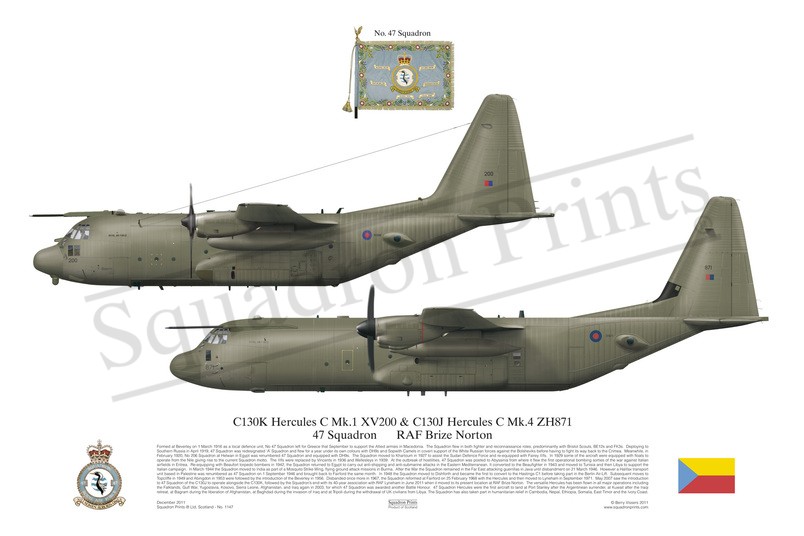#1147 Hercules C1; Hercules C4

Purchased products will not feature the Squadron Prints watermark
Description
Squadron Prints Lithograph No. 1147 - C130K Hercules C Mk.1 XV200 & C130J Hercules C Mk.4 ZH871, 47 Squadron, RAF Brize Norton.
Formed at Beverley on 1 March 1916 as a local defence unit, No 47 Squadron left for Greece that September to support the Allied armies in Macedonia. The Squadron flew in both fighter and reconnaissance roles, predominantly with Bristol Scouts, BE12s and FK3s. Deploying to Southern Russia in April 1919, 47 Squadron was redesignated ‘A’ Squadron and flew for a year under its own colours with DH9s and Sopwith Camels in covert support of the White Russian forces against the Bolsheviks before having to fight its way back to the Crimea. Meanwhile, in February 1920, No 206 Squadron at Helwan in Egypt was renumbered 47 Squadron and equipped with DH9s. The Squadron moved to Khartoum in 1927 to assist the Sudan Defence Force and re-equipped with Fairey IIIfs. In 1929 some of the aircraft were equipped with floats to operate from the Nile giving rise to the current Squadron motto. The IIIfs were replaced by Vincents in 1936 and Wellesleys in 1939. At the outbreak of hostilities, 47 Squadron was posted to Abyssinia from where it flew the first operational bombing sorties of the war against Italian airfields in Eritrea. Re-equipping with Beaufort torpedo bombers in 1942, the Squadron returned to Egypt to carry out anti-shipping and anti-submarine attacks in the Eastern Mediterranean. It converted to the Beaufighter in 1943 and moved to Tunisia and then Libya to support the Italian campaign. In March 1944 the Squadron moved to India as part of a Mosquito Strike Wing, flying ground attack missions in Burma. After the War the Squadron remained in the Far East attacking guerrillas in Java until disbandment on 21 March 1946. However a Halifax transport unit based in Palestine was renumbered as 47 Squadron on 1 September 1946 and brought back to Fairford the same month. In 1948 the Squadron moved to Dishforth and became the first to convert to the Hastings C1 before taking part in the Berlin Air-Lift. Subsequent moves to Topcliffe in 1949 and Abingdon in 1953 were followed by the introduction of the Beverley in 1956. Disbanded once more in 1967, the Squadron reformed at Fairford on 25 February 1968 with the Hercules and then moved to Lyneham in September 1971. May 2007 saw the introduction to 47 Squadron of the C130J to operate alongside the C130K, followed by the Squadron’s end with its 40-year association with RAF Lyneham in June 2011 when it moved to its present location at RAF Brize Norton. The versatile Hercules has been flown in all major operations including the Falklands, Gulf War, Yugoslavia, Kosovo, Sierra Leone, Afghanistan, and Iraq again in 2003, for which 47 Squadron was awarded another Battle Honour. 47 Squadron Hercules were the first aircraft to land at Port Stanley after the Argentinean surrender, at Kuwait after the Iraqi retreat, at Bagram during the liberation of Afghanistan, at Baghdad during the invasion of Iraq and at Tripoli during the withdrawal of UK civilians from Libya. The Squadron has also taken part in humanitarian relief in Cambodia, Nepal, Ethiopia, Somalia, East Timor and the Ivory Coast.
You may also like
-
The 2023 Red Arrows hand signed Squadron Print
XX219The Red ArrowsRAF Waddington
